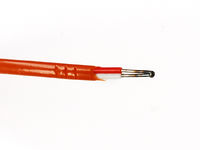Thermocouple
Thermocouple
A thermocouple is a junction between two different metals that produces a voltage related to a temperature difference. Thermocouples are a widely used type of temperature sensor for measurement and control and can also be used to convert heat into electric power. They are inexpensive and interchangeable, are supplied fitted with standard connectors, and can measure a wide range of temperatures.
Principle of Operation
In 1821, the German–Estonian physicist Thomas Johann Seebeck discovered that when any conductor is subjected to a thermal gradient, it will generate a voltage. This is now known as the thermoelectric effect or Seebeck effect. Any attempt to measure this voltage necessarily involves connecting another conductor to the "hot" end. This additional conductor will then also experience the temperature gradient, and develop a voltage of its own which will oppose the original. Fortunately, the magnitude of the effect depends on the metal in use. Using a dissimilar metal to complete the circuit creates a circuit in which the two legs generate different voltages, leaving a small difference in voltage available for measurement. That difference increases with temperature, and is between 1 and 70 microvolts per degree Celsius (µV/°C) for standard metal combinations. The voltage is not generated at the junction of the two metals of the thermocouple but rather along that portion of the length of the two dissimilar metals that is subjected to a temperature gradient. Because both lengths of dissimilar metals experience the same temperature gradient, the end result is a measurement of the temperature at the thermocouple junction.
See also
For comparison to thermistors see Thermocouple vs Thermistor.
